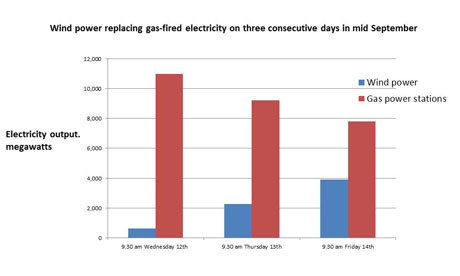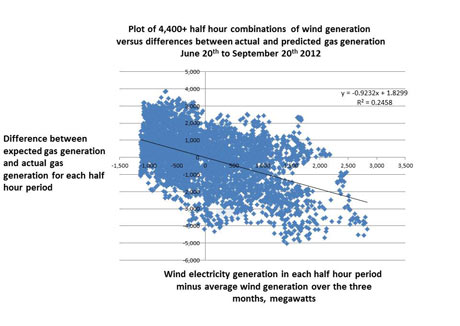It's a myth that wind turbines don't reduce carbon emissions
Conclusive figures show that the sceptics who lobby against wind power simply have their facts wrong
The assertion that wind turbines don't reduce carbon emissions is a myth, according to conclusive statistical data obtained from National Grid and analysed here in the Guardian for the first time. With a new wind generation record of 4,131 megawatts set on 14 September, the question of how far the UK's wind generation fleet can help in meeting our climate targets is increasingly controversial. Now it can be shown that the sceptics who lobby against wind simply have their facts wrong.

On 14 September, wind turbines connected to the National Grid produced over 80 gigawatt-hours (GWh) of electricity, just over 10% of total UK generation. This was far from being a one-off: with more than 4,000 turbines both on and offshore now connected to the grid, wind produced 48 GWh of usable electricity per day on average during September, adding up to about 6% of overall daily national electricity requirement. On many days, wind is now the fourth-largest source of UK electricity, after coal, nuclear and gas. Indeed, this figure is a significant underestimate, because about two gigawatts of wind are connected directly to local networks and so not directly visible to National Grid.
However, according to increasingly vocal critics of wind power, the intermittent nature of wind generation means we must burn more gas to provide backup. According to Telegraph columnist Christopher Booker:
"Ramping the back-up gas plants up and down would mean running them very inefficiently, and give off so much CO2 that we could end up increasing our overall emissions rather than reducing them"
Journalist and author Matt Ridley asserts that:
"The total carbon emissions saved by the great wind rush is probably below 1%, because of the need to keep fossil fuels burning as back-up when the wind does not blow. It may even be a negative number."
The climate-sceptic Global Warming Policy Foundation (GWPF) recently gave evidence to the House of Commons energy and climate changecommittee, stating:
"There is a significant risk that annual CO2 emissions could be greater under the wind scenario than under the gas scenario".
The essence of the wind sceptics' case is that a scaling up in wind power will have to be "backed up" by massive investment in gas-fired open cycle turbine (OCGT) plants, which are cheap to build but considerably less efficient than the combined cycle gas turbine (CCGT) power plants which deliver the vast majority of the UK's gas-fired electricity supply.
Their arguments are not borne out by current statistics, however. If the sceptics were right, the recent windy conditions would have seen considerable use of less-efficient OCGT as wind input to the grid ramped up and down. In actual fact, during the entire June-September period, OCGTs and equally dirty oil-fired stations produced less than one hundredth of one percent of all UK electricity. In total they operated for a grand total of just nine half hour periods in the first 19 days of the month – and these periods had nothing to do with changing windspeeds.
From analysing National Grid data of more than 4,000 half-hour periods over the last three months, a strong correlation between windiness and a reduction in gas-fired generation becomes clear. The exchange rate is about one for one: a megawatt hour of wind typically meant the UK grid used one less megawatt hour of gas-derived electricity. This means that actual CO2 savings can be calculated from the data with a high degree of accuracy – these are not guesstimates from models, but observations of real-world data.

Over a year, based on the amount of electricity wind is currently generating each day, wind turbines save around 6.1m tonnes of carbon dioxide, or about 4% of the UK's emissions from electricity (based on CCGT plants emitting around 350 kg CO2 per mWh). This figure provides independent confirmation for the trade body RenewableUK'sestimate of a current reduction in annual emissions from the entire UK wind fleet of about 6m tonnes.
Looking to the future, about 26 gigawatts of onshore and offshore wind is expected to be connected to the grid by 2020, nearly four times today's capacity. Even so, National Grid expects to be able to handle the increased wind generation without major new investment in dirty open-cycle gas backup, contradicting the claims from the GWPF.
The National Grid's Gillian West says:
As more wind connects, there will be a need for additional back-up for that intermittency ... [however] there will be moreinterconnection with mainland Europe and new storage technologies may also emerge (eg battery) or additional pumped storage hydro which can provide short term response.
National Grid is also improving its wind forecasting system to make coping with times of low demand and high generation easier.
Indeed, the wind sceptics may have their case backwards. The biggest blackout risk is not intermittent wind but the threat of total loss of a single giant power source, such as a large coal or nuclear plant, possibly within just a few seconds. But the grid is already engineered to withstand this catastrophic loss with existing back-up – and wind is unlikely to change this picture for the foreseeable future.

The intermittency of wind is balanced both by the inertia of the turbines themselves and by multiple wind installations over a wide geographical area. In addition, wind is now forecasted with reasonable accuracy at least a day in advance, allowing National Grid to plan the right generation mix to accompany it. Indeed, the most difficult issues for the Grid come from the demand side – commercial breaks in Downton Abbey can lead to sudden demand spikes of hundreds of megawatts in just a few seconds. Wind, in contrast, fades up and down much more slowly.
The researcher Damon Hart-Davis, who maintains a real-time website showing the grid's carbon intensity called Earth Notes, confirms separately that when the wind is blowing the UK emits less CO2 per unit of electricity generated. This is much more visible currently than it has been in previous years because wind is now a significant enough player to stand out from the statistical noise, which include electricity produced by Welsh pumped-storage hydroelectricity and imports and exports from France, Holland and Ireland.
The UK may be the windiest country in Europe, but other nations already have much greater installed capacity. Spain, for example, occasionally produces 50% of its power from wind turbines with no impact on its electricity grid.
Continued fast expansion in offshore and onshore wind is good news for carbon emissions and can be accommodated without major problems by the grid. Data, not assertions, are what must win the argument over wind – and the data is very clear.
No hay comentarios:
Publicar un comentario